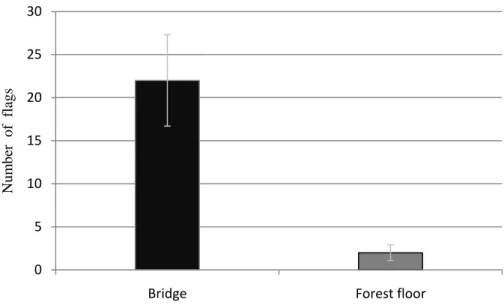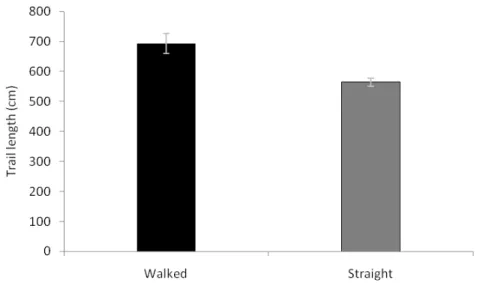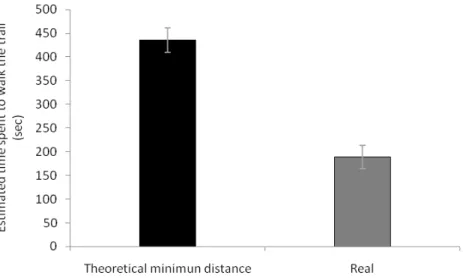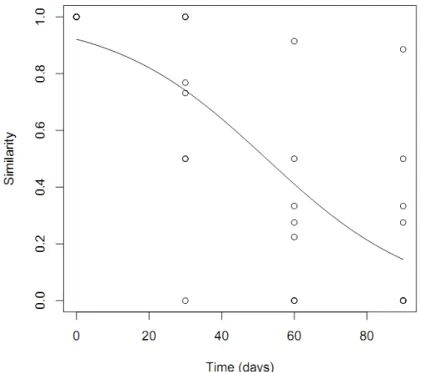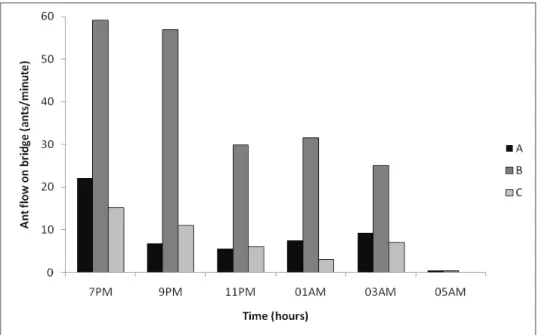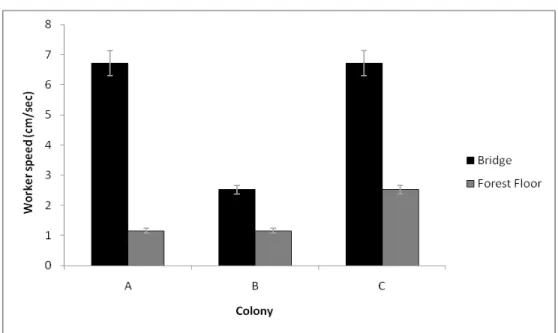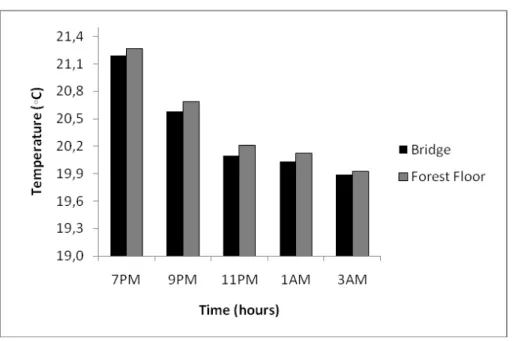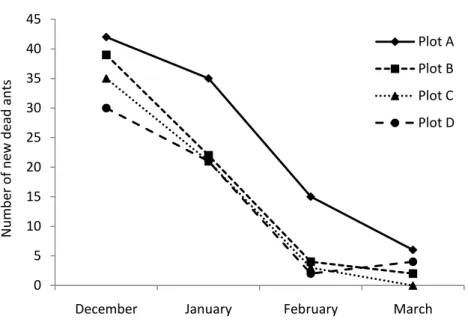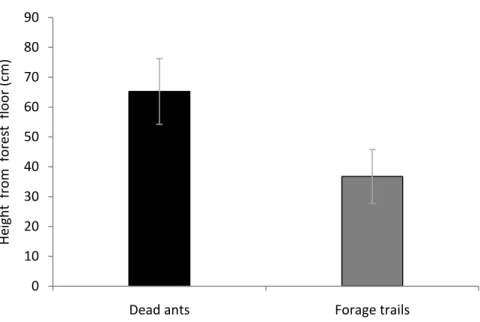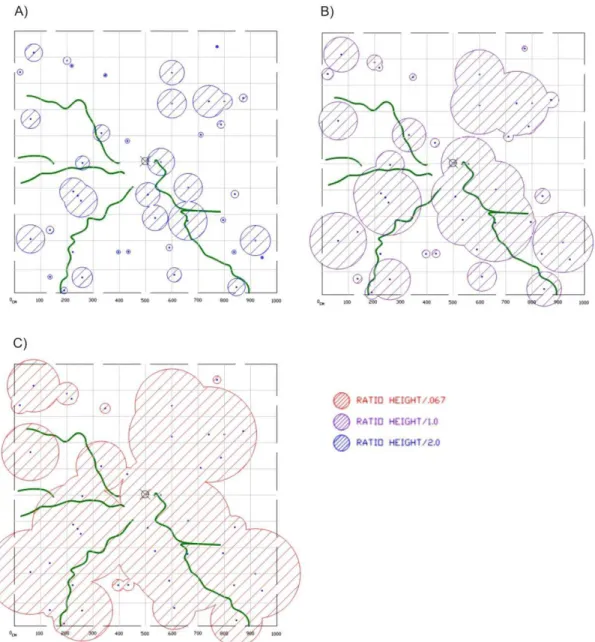RAQUEL GONTIJO DE LORETO
DISEASE RISK AND FORAGING IN Camponotus rufipes (FORMICIDAE, FORMICINAE)
Dissertação apresentada à Universidade Federal de Viçosa, como parte das exigências do Programa de Pós-Graduação em Entomologia, para obtenção do título de Magister Scientiae.
VIÇOSA
RAQUEL GONTIJO DE LORETO
DISEASE RISK AND FORAGING IN Camponotus rufipes (FORMICIDAE, FORMICINAE)
Dissertação apresentada à Universidade Federal de Viçosa, como parte das exigências do Programa de Pós-Graduação em Entomologia, para obtenção do título de Magister Scientiae.
APROVADA: 17 de junho de 2011.
Prof. Dr. José Henrique Schoereder Co-orientador
Dr. Harold Charles Evans
Prof. Eduardo Seiti Gomide Mizubuti
ii
iii
AGRADECIMENTOS
“Agradeço todas as dificuldades que enfrentei; não fosse por elas, não teria saído do
lugar. As facilidades me impedem de caminhar” (Chico Xavier)
À Universidade Federal de Viçosa pela formação em Ciências Biológicas em mestre em Entomologia. Ao Conselho Nacional de Desenvolvimento Científico e Tecnológico (CNPq) pela concessão da bolsa de mestrado.
Ao professor Sam, meu orientador desde a graduação, pelos ensinamentos,
conselhos e, principalmente, pelas oportunidades a mim confiadas. “Great teachers
inspire”.
Ao professor David Hughes pelo apoio logístico, financeiro e intelectual em todas as fases de desenvolvimento desse trabalho.
Ao co-orientador José Henrique Schoereder, pelas sugestões no projeto e apoio intelectual nas análises estatísticas dos dados, e pela presença na banca de defesa de dissertação.
Ao pesquisador visitante Harry Evans e ao professor Eduardo Mizubuti pela participação na banca de defesa de dissertação.
A todos os colegas do Laboratório de Interações Inseto-Microrganismo pela convivência e discussões científicas.
iv
Aos meus queridos pais, Sérgio e Elisete, pelo precioso suporte emocional, que foi indispensável para superar a distância. Em especial, agradeço por acreditarem em mim e me apoiarem de forma incondicional na busca de meus objetivos, por me levantarem a cada queda e vibrarem a cada conquista.
Aos meus irmãos, Breno e Tati, e ao meu cunhado Geraldo, por sempre estarem ao meu lado, torcendo por mim.
v
ÍNDICE
RESUMO ... vii
ABSTRACT ... viii
REVISÃO DE LITERATURA ... 1
Ant foraging ... 1
Insect-pathogens interactions ... 2
Ophiocordyceps unilateralis: extended phenotype ... 4
References ... 6
INTRODUÇÃO GERAL ... 11
Introdução ... 11
Referências ... 14
CAPÍTULO 1 ... 16
Abstract ... 17
Introduction ... 18
Methods ... 20
Study area and species ... 20
Data Collection ... 21
Do ants use bridges more than the forest floor? ... 22
Do ants trade off “further” for “faster”? ... 22
Are trails on bridges longer-lasting than trails on the forest floor? ... 24
Results ... 24
Ants use bridges more than the forest floor ... 24
Ants trade off “further” for “faster” ... 25
Trails on bridges do not last longerg than trails on the forest floor ... 28
vi
References ... 32
Supplementary material ... 37
CAPÍTULO 2 ... 40
Abstract ... 41
Introduction ... 42
Results and Discussion ... 44
System description ... 44
Fungus versus ant height ... 55
Spatial distribution of infected dead ants ... 56
Material and Methods ... 60
Study area and ant species ... 60
Data collection ... 60
System description ... 61
Fungus versus ant height ... 62
Spatial distribution of infected dead ants ... 62
References ... 63
vii
RESUMO
LORETO, Raquel Gontijo de, M.Sc., Universidade Federal de Viçosa, junho de 2011. Disease risk and foraging in Camponotus rufipes (Formicidae, Formicinae) Orientador: Simon Luke Elliot. Co-orientadores: José Henrique Schoereder e Og Francisco Fonseca de Souza
viii
ABSTRACT
LORETO, Raquel Gontijo de, M.Sc., Universidade Federal de Viçosa, June, 2011. Disease risk and foraging in Camponotus rufipes (Formicidae, Formicinae) Adviser: Simon Luke Elliot. Co-advisers: José Henrique Schoereder and Og Francisco Fonseca de Souza
Parasites have effects on their hosts in different ways, range from indirect effects to manipulation of host. In social insects, the parasite-host relationship are more complex once living in group has consequences on parasitism. Then, it is known the parasites represent a great pressure over social insects. The pathogenic fungi Ophiocordyceps unilateralis sensu lato is an ant pathogen limited to Camponotini tribe. This parasite, obligate killer,
1
REVISÃO DE LITERATURA Ant foraging
Ants (Hymenoptera, Formicidae) occur in all terrestrial habitats except the poles, and they are the dominant members of the communities they occupy. They inhabit a large variety of niches as being direct herbivores, indirect herbivores and predators (Hölldobler & Wilson 1990). However, most species of ants are generalist omnivores.
2
1990). Associated with the division of labour, this foraging efficiency has been used to explain the dominance of ants biomass compared with other insects (Bourke et al. 1995, Wilson & Hölldobler 2005).
Insect-pathogen interactions
Insect-pathogen interactions are quite diverse (Bonsall 2004), and may have direct and indirect consequences on the insect host. A common outcome of disease is the death of the host. Nevertheless, many other sublethal or indirect effects arise from disease, such as alterations in behavior (Orr 1992, Elliot et al. 2002, Bonsall 2004, Andersen et al. 2009), coloration (Fenton et al. 2011), food intake, development (Nathan et al. 2006, Roy et al. 2006) and susceptibility to secondary predation or parasitism (Arthurs e Thomas 2001, Ban et al. 2008).
With respect to eusocial insects, the fact that they live in groups can complicate the host-pathogen interaction. It is expected that pathogen transmission among these individuals by direct contact is more frequent than in solitary insects (McCallum et al. 2001). Thus, the necessity of information transmission and all life stages occurring inside the nest represent an increased dispersion and different habits to be explored by parasites (Schmid-Hempel 1998).
On the another hand, social insects have many defenses that minimize the chances of success of pathogens. Schmid-Hempel & Ebert (2003) refer to a “cascade of defense
components” which would be composed of different resistance mechanisms, acting in
3
minimize the diseases (Cremer et al. 2007). The division of labor as a behavioral mechanism of defense is consistent with the conveyor belt model proposed by Schmid-Hempel (1998). According to him, younger workers remain inside the nest but as they age they go outside the nest. There they undertake activities such as foraging and defense that carry greater mortality risks, as they have become a less valuable class of workers. Thus, age polyethism is a central feature of the model. These older workers are assumed never to come back closer to the queen and the brood of colony, and therefore this division increases the life span of the individuals and of the colony. Empirical data reinforce this as leaf-cutting ant foragers are less resistant to an entomopathogenic fungus than the workers inside the nest (Fellet et al. in prep.).
To an obligatory pathogen, these defenses can result in a coevolutionary “arms
race” which may affect the frequency of resistant genotypes in a population (Jaenike 1978,
4
than induce defensive behavioral changes: they manipulate their hosts’ behavior, thereby
increasing their own fitness (Thomas et al 2002, Grosman et al. 2008). Ophiocordyceps unilateralis: extended phenotype
Insect-entomopathogenic fungi probably have an important role in regulating insect population dynamics in tropical forests (Evans & Samson 1982). The life cycles of these organisms are synchronized with their host stages and environmental conditions (Shah & Pell 2003), and most of them need to kill their host to complete the cycle. The hosts of entomopathogenic fungi become infected after the spores penetrate the external cuticle of the insect skeleton. Inside the insect body, in the haemolymph, the fungi produce yeast-like cells that grow and spread throughout the insect acquiring nutrients. It is probable that fungi use different strategies to kill their hosts, some causing host death by physiological starvation and others by producing toxins (Kershaw et al. 1999). Following host death, the fungus must penetrate the insect cuticle again, this time from the inside out, to produce propagules outside the host body that are able to infect other hosts, completing the cycle (Samson et al. 1988).
The genus Ophiocordyceps (Hypocreales, Claviciptaceae) consists of more than 150 species of entomopathogens that infect different arthropod groups (Sung et al. 2007). Ophiocordyceps unilateralis, formerly known as Cordyceps unilateralis, infects ants of the
Camponotini tribe (Evans 2003), such as C. rufipes. This fungus is a common ant pathogen that is usually registered in the tropics and subtropics, with sporadic records in temperate habitats.
5
The infected host ant, when in this appropriate locale, bites the underside vein of a leaf, on the north-northwest side of the plant, at approximately 25 cm from the ground. This active fungal positioning of host in the well-defined manipulative zone can be considered an extended phenotype and it increases the fitness of the fungus. This interaction is particularly interesting because the ant host nests in the canopy and its trails are
concentrated in the canopy, yet the fungal spores create an infectious “killing field” on the
ground, where it is dispersed over short distances (Andersen et al. 2009).
In an evergreen primary forest in Thailand, O. unilateralis infects the host C. leonardi (Andersen et al. 2009, Pontoppidan et al. 2009). This ant host has a canopy nest
6
References
Andersen, S. B., Gerritsma, S., Yusah, K.M., Mayntz, D., Hywel-Jones, N.Y., Billen, J., Boomsma, J.J. & Hughes, D.P. 2009. The life of a dead ant: the expression of an adaptive extended phenotype. American Naturalist, 174, 424-433.
Arthus, S. & Thomas, M.B. 2001. Behavioural changes in Schistocerca gregaria following infection with a fungal pathogen: implications for susceptibility to predation. Ecological Entomology, 26, 227-234.
Ban, L., Ahmed, E., Ninkovic, V., Delp, G. & Glinwood, R. 2008. Infection with an insect virus affects olfactory behaviour and interactions with host plant and natural enemies in an aphid. Entomologia Experimentalis et Applicata, 127, 108–117.
Beckrs, R., Deneubourg, J. L, Goss, S. & Pasteels, J. M. 1990. Collective decision making through food recruitment. Insectes Sociaux, 37, 258-267.
Bonsall, M.B. 2004. The impact of diseases and pathogens on insect population dynamics. Physiological Entomology, 29, 223-236.
Bourke, A. F. G., Franks, N. R.1995. Social evolution in ants. Princeton, New York: Princeton University Press.
Buhl, J., Hicks, K., Miller, E., Persey, S., Alinvi, O. & Sumpter, D. 2009. Shape and efficiency of wood ant foraging networks. Behavioral Ecology and Sociobiology, 63, 451-460.
Cremer S., Armitage S. A. O., Schmid-Hempel P. 2007. Social immunity. Current Biology, 17, 693–702.
Elliot, S.L., Blanford, S. & Thomas, M.B. 2002. Host pathogen interactions in a varying environment: temperature, behavioural fever and fitness. Proceedings Royal Society London, 269, 1599-1607.
Evans, H. C. & Samson, R. A. 1982. Cordyceps species and their anamorphs pathogenic on ants (Formicidae) in tropical forest ecosystems. I. The Cephalotes ( Myrmycinae) complex. Transactions of the British Mycological Society, 79, 431-453.
7
Evans, H.C. 2003. Entomopathogenic fungi associated with ants (Formicidae): A review. In: Trichomycetes and Other Fungal Groups (Eds Mirsa, J.K & Horn, B. W.), pp 119-144. Enfield: Science Publishers.
Evans, H.C., Elliot, S. L., Hughes, D.P. 2011. Hidden diversity behind the zombie- ant fungus Ophiocordyceps unilateralis: For new species described from carpenter ants in Minas Gerais, Brazil. PLoS ONE, 6 e17024.
Evison, S. E. F., Hart, A. G. & Jackson, D. E. 2008. Minor workers have a major role in the Maintenance of leafcutter ant pheromone trails. Animal Behavior, 75, 963-969. Feener Jr., D.H. 1988. Effectes of parasites on foraging and defense behaviour of a
termitophagous ant, Pheidole titanis Wheeler (Hymenoptera: Formicidae). Behavioral Ecology and Sociobiology, 22, 421-427.
Fellet, M.R., Loreto, R.G. & Elliot, S.L. (in prep). Polyethism lifespan in Atta levigata workers.
Fenton, A., Magoolagan, L., Kennedy, Z. & Spencer, K.A. 2001. Parasite-induced warning coloration: a novel form of host manipulation. Animal Behaviour, 81, 417-422.
Grosman, A.H., Janssen, A.; de Brito, E.F.; Cordeiro, E.G.; Colares, F.; Fonseca, J.O.; Lima, E.R.; Pallini, A.; Sabelis, M.W.; Raine, N.E. 2008. Parasitoid Increases Survival of Its Pupae by Inducing Hosts to Fig ht Predators. PLoS ONE, 3 e2276.
Hamilton, W.D. 1980. Sex versus non-sex parasite. Oikos, 35, 282–90.
Hölldobler, B. & Wilson, E.O. 1990. The Ants. Cambridge, Massachussets: Belknap Press of Harvard University Press.
Hunt, G. J & Page, R.E. 1995. Linkage map of the honey bee, Apis mellifera, based on RAPD markers. Genetics, 139, 1371-1382.
Jaenike, J. 1978. An hypothesis to account for the maintenance of sex within populations. Evolutionary Theory, 3, 191-194.
8
Keller, L. 1995. Parasites, worker polymorphism, and queen number in social insects. American Naturalist, 145, 842-847.
Kershaw, M.J., Moorhouse, E.R, Bateman,R., Reynolds S. E. & Charnley A.K. 1999. The role of destruxins in the pathogenicity of Metarhizium anisopliae for three species of Insect. Journal of Invertebrate Pathology, 74, 213–223.
McCallum, H; Barlow, M & Hone, J. 2001. How should pathogen transmission be modelled? Trends in Ecology and Evolution, 16, 295-300.
Meikle, W.G.; Mercadier, G.; Rosengaus, R.B.; Kirk, A.A. Derouane, F. & Quimby, P.C. 2005. Evaluation of an entomopathogenic fungus, Paecilomyces fumosoroseus (Wize) Brown and Smith (Deuteromycota: Hyphomycetes) obtained from Formosan subterranean termites (Isop., Rhinotermitidae). Journal of Applied Entomology, 129,
315-322.
Nathan, S.S.; Kalaivani, K. & Murugan, K. 2006. Behavioural responses and changes in biology of rice leaffolder following treatment with a combination of bacterial toxins and botanical insecticides. Chemosphere, 64, 1650–1658.
Orr, M.R. 1992. Parasitic flies (Diptera: Phoridae) influence foraging rhythms and caste division of labor in the leaf-cutter ant, Atta cephalotes (Hymenoptera: Formicidae). Behavioral Ecology and Sociobiology, 30, 395-402.
Orr, M.R.; Seike, S.H. & Gilbert, L.E. 1997. Foraging ecology and patterns of diversification in dipteran parasitoids of fire ants in South Brazil. Ecological Entomology, 22, 305-314.
Pontoppidan, M.B.,Himaman, W.,Hywel-Jones, N.L., Boomsma, J.J., & Hughes, D.P. 2009. Graveyards on the move: the spatio-temporal distribution of dead Ophiocordyceps-infected ants. PLoS ONE, 4, e4835.
Reid, C. R.; Sumpter, D. J. T. & Beekman, M. 2011. Optimisation in a natural system: Argentine ants solve the Towers of Hanoi. Journal of Experimental Biology, 214, 50-58.
9
Roy, H.E.; Steinkraus, D.C.; Eilenberg, J. & Hajek, A.E. 2006. Bizarre interactions and endgames: entomopathogenic fungi and their arthropod hosts. Annual Review of Entomology, 51, 331–57.
Samson, R.A., Evans, H.C. & Latgé, J.P. 1988. Atlas of entomopathogenic fungi. New York, New York: Springer
Schmid-Hempel, P. 1998.Parasites in Social Insects. Princeton University Press. Princeton, New Jersey, United States. 392 pp.
Schmid-Hempel, P. & Schmid-Hempel, R. 1993. Transmission of a pathogen in Bombus terrestris, with a note on division of labour in social insects. Behavioral Ecology and
Sociobiology, 33, 319-327.
Schmid-Hempel, P. & Ebert, D. 2003.On the evolutionary ecology of specific immune defence. Trends in Ecology and Evolution, 18, 27-32.
Shah, P.A., Pell, J.K.2003. Entomopathogenic fungi as biological control agents. Applied Microbiology and Biotechnology, 61, 413–423.
Sirviö, A., Gadau, J., Rueppel, O., Lamatsch, D., Boomsma, J.J., Pamilo, P. & Page Jr., R.E. 2006. High recombination frequency creates genotypic diversity in colonies of the leaf-cutting ant Acromyrmex echinatior. European Society for Evolotionary Biology, 19, 1475–1485.
Sung, G.H., Hywel-Jones, N.L., Sung, J.M., Luangsa-Ard, J.J., Shrestha, B. & Spatafora, J.W. 2007. Phylogenetic classification of Cordyceps and the clavicipitaceous fungi. Studies in Mycology, 57,5–59.
Thomas, F., Schmidt-Rhaesa, A., Martin, G., Manu, C.; Durand, P. & Renaud, F. 2002. Do hairworms (Nematomorpha) manipulate the water seeking behaviour of their terrestrial hosts?. Journal of Evolutionary Biology, 15, 356-361.
Traniello, J.F.A. 1989. Foraging strategies of ants. Annual Review of Entomology, 34,191-210.
Wilson, E.O.1962. Chemical communication among workers of fire ant Solenopsis saevissima (Fr. Smith): I. The organization of mass foraging; II. An information
10
11
INTRODUÇÃO Introdução geral
Estudos sobre interações entre insetos e patógenos vêm apresentando grande desenvolvimento nos últimos anos, desde pesquisas básicas sobre a dinâmica do patógeno ou hospedeiro, até investigações de uso de agentes microbianos para o controle biológico de pragas (Thomas et al. 2003). A ecologia das interações inseto-patógeno é bastante diversa (Bonsall 2004), tendo consequências diretas e indiretas sobre o inseto hospedeiro, sendo que o principal resultado dessa interação é a sua morte. No entanto, muitos outros efeitos indiretos oriundos dessa relação são discutidos, como: mudanças comportamentais (Elliot et al. 2002, Bonsall 2004), alteração do consumo alimentar, atividade e estágios de desenvolvimento do inseto (Nathan et al. 2006, Roy et al. 2006, Hernández-Velázquez et al. 2007) e aumento da susceptibilidade à predação e parasitismo (Arthurs e Thomas 2001, Ban et al. 2008).
12
móvel, como os fungos entomopatogêncios, o local no qual o hospedeiro morre pode ser muito importante para a transmissão da doença a novos hospedeiros. Nesse contexto, uma eficiente estratégia é manipular o hospedeiro e garantir que este morra em local adequado (McCurdy et al. 1999, Thomas et al. 2002), que otimiza o fitness do parasita manipulador.
Um exemplo de manipulação de hospedeiros é o sistema Ophiocordyceps unilateralis sensu lato e formiga hospedeira. O fungo parasita Ophiocordyceps controla o
comportamento da formiga infectada, conduzindo a hospedeira até uma localização precisa antes que ela morra. Na Tailândia, formigas da espécie Camponotus leonardi, infectadas pelo fungo, morrem à 25cm do solo da floresta, onde a esporulação do fungo é máxima (Andersen et al. 2009). Também se sabe que as formigas infectadas pelo O. unilateralis encontram-se agregadas (Pontoppidan et al. 2009). Mesmo que o fungo conduza a formiga até uma localização específica, onde se crescimento é elevado, se os esporos não alcançarem formigas vivas sadias, o ciclo do fungo não se fechará. Como as formigas vivas geralmente se distribuem no espaço seguindo trilhas de forrageamento, essas trilhas representam para o fungo fonte de novos possíveis hospedeiros. Nesse contexto, consideramos que seja importante entender a ecologia do comportamento de forrageamento das formigas, antes de estudar a interação entre parasita e hospedeiro.
13
otimizado. Assim sendo, esperávamos encontrar maior permanência, ao longo do tempo, das partes da trilha que passavam por pontes em relação aquelas que passavam pelo solo. A partir de nossos resultados, nós concluímos que, em condições naturais, as formigas otimizam suas rotas não usando o caminho mais curto, e sim o caminho mais rápido. As pontes tornam o caminho mais longo, mas nós estimamos que as formigas gastem 2,4 vezes menos tempo para chegar a um determinado ponto, usando as pontes. Nós também concluímos que as pontes são mantidas ao longo do tempo, caracterizando trilhas-troncos.
Após entender melhor sobre o forrageamento da formiga hospedeira, focamos em estudar a distribuição das formigas mortas infectadas no espaço. Conforme os estudos com Ophiocordyceps unilateralis sensu lato tem mostrado a capacidade de manipular
14
Referências
Andersen, S.B., Gerritsma, S., Yusah, K.M., Mayntz, D., Hywel-Jones, N.L., Billen, J., Boomsma, J.J. & Hughes, D.P. 2009. The life of a dead ant: the expression of an adaptive extended phenotype. American Naturalist, 174, 424-433.
Arthus, S. & Thomas, M.B. 2001. Behavioural changes in Schistocerca gregaria following infection with a fungal pathogen: implications for susceptibility to predation. Ecological Entomology, 26, 227-234.
Aylor, D.E. 1990. The role of intermittent wind in the dispersal of fungal pathogens. Annual Review of Phytopathology, 28, 73-92.
Ban, L., Ahmed, E., Ninkovic, V., Delp, G. & Glinwood, R. 2008. Infection with an insect virus affects olfactory behaviour and interactions with host plant and natural enemies in an aphid. Entomologia Experimentalis et Applicata, 127, 108–117.
Bonsall, M.B. 2004. The impact of diseases and pathogens on insect population dynamics. Physiological Entomology, 29, 223–236.
Bruck, D.J., & Lewis, L.C. 2002. Rainfall and crop residue effects on soil dispersion and Beauveria bassiana spread to corn. Applied Soil Ecology, 20, 183–190.
Ebert, D. & Weisser, W.W. 1997. Optimal killing for obligate killers: The evolution of life histories and virulence of semelparous parasites. Proceeding of the Royal Society London B, 264, 985–991.
15
Hernández-Velázquez, V.E., Berlanga-Padilla, A. & Toriello, C. 2007. Reduction of feeding by Schistocerca piceifrons piceifrons (Orthoptera: Acrididae), following infection by Metarhizium anisopliae Var. Acridum. Florida Entomologist, 90, 786-789.
Kaya, H.K. & Gaugler, R. 1993 Entomopathogenic nematodes. Annual Review of Entomology, 38, 181e206.
McCurdy, D.G., Forbes, M.R. & Boates, J.S. 1999. Evidence that the parasitic nematode Skrjabinoclava manipulates host Corophium behavior to increase transmission to the
sandpiper, Calidris pusilla. Behavioral Ecology, 10, 351–357.
Nathan, S.S.; Kalaivani, K. & Murugan, K. 2006. Behavioural responses and changes in biology of rice leaffolder following treatment with a combination of bacterial toxins and botanical insecticides. Chemosphere, 64, 1650–1658.
Pontoppidan, M.B., Himaman, W., Hywel-Jones, N.L., Boomsma, J.J., & Hughes, D.P. 2009. Graveyards on the move: the spatio-temporal distribution of dead Ophiocordyceps-infected ants. PLoS ONE, 4, e4835.
Roy, H.E.; Steinkraus, D.C.; Eilenberg, J. & Hajek, A.E. 2006. Bizarre interactions and endgames: entomopathogenic fungi and their arthropod hosts. Annual Review of Entomology, 51, 331–57.
Thomas, F., Schmidt-Rhaesa, A., Martin, G., Manu, C., Durand, P. & Renaud, F. 2002. Do hairworms (Nematomorpha) manipulate the water seeking behaviour of their terrestrial hosts? Journal of Evolutionary Biology, 15, 356-361.
16
CAPÍTULO 1:
Foraging ants trade off further for faster: use of natural bridges and trunk-trail permanency in carpenter ants
Raquel G. Loreto, Thairine Mendes Pereira, Mayara L. R. Freitas, Adam G. Hart & Simon L. Elliot
17
Foraging ants trade off further for faster: use of natural bridges and trunk-trail permanency in carpenter ants
Raquel G. Loreto, Thairine Mendes, Mayara L. R. Freitas, Adam G. Hart & Simon L. Elliot
The self-organized nature of many biological networks, where solutions to problems
emerge through the interaction of relatively simple “agents”, has potential for bio-inspired
18
Studies of the organization of complex animal societies can provide direct insight into the evolution of social behavior in higher organisms. Such studies can also provide insight into the major transitions of evolution, in particular the evolution of multi-cellular life from interacting groups of more-or-less cooperative single cells (Smith & Szathmary 1997). However, the self-organized nature of many biological networks, where solutions to
problems emerge through the interaction of relatively simple “agents”, has potential for
bio-inspired solutions to similar problems in the human world. For example, the complex foraging behavior exhibited by trail-making ants inspired the creation of Ant Colony Optimization algorithms (ACO) that can solve (or at least provide great insight into) diverse problems including telephone networks (Zhao et al. 2010) and delivery schedules (Lee 2009).
19
Many studies have supported the hypothesis that ant colonies can optimize foraging by, for example, choosing the best resource (Beckers et al. 1990). Ants can also maximize forage return by creating an alternative trail route in crowded situations (Dussutuor et al. 2004) and are able to find the shortest route in complex dynamic situations (Reid et al. 2011). Other studies have also demonstrated the importance and adaptive significance of efficient decision making at trail bifurcations, which are typical of ant foraging networks (Jackson et al. 2004, Vittori et al. 2006, Garnier et al. 2009). However, a particular question that has not been addressed is how ants adapt to differences in the terrain over which they travel. Furthermore, pheromone studies have mostly been carried out in the laboratory and are therefore severely limited with respect to the insight they can offer to ant foraging under real, and complex, ecological scenarios.
Very few studies have examined trail optimization in field conditions. One study that has (Buhl et al. 2009) showed that the foraging trail network of the wood ant Formica aquilonia optimizes the total length of trail and the distance between the source and nest.
20
where the quality of the road surface – dirt tracks versus asphalt, for example – can be an important factor in deciding the best route.
We set out to investigate how ants use bridges in a field setting, in particular whether they use bridges that are not aligned with their trails. Preliminary observations showed that the foraging trails of carpenter ants (Camponotus rufipes; Hymenoptera: Camponitini) followed fallen branches, twigs and lianas, using these bridges as part of the trail. As this seems to make their trails longer, we hypothesized that the longer route, where
it includes these bridges, is the optimal route; that is, the ants are trading off “further” for
“faster”. If this is the case, then we expect to see a consistency in the pattern of use of these
bridges through time, as is seen in leafcutting ant trunk trails (Farji-Brener et al. 2007); thus, our second hypothesis is that trails will be longer-lived when on bridges than when on the forest floor.
METHODS
Study area and species
21
arthropods (Jaffe & Sanchez 1984, Del-Claro & Oliveira 2000). In this habitat, C. rufipes is active at night, with activity peaking in the early evening (Figure S1, Supplementary material).
Data collection
Four established nests of C. rufipes were identified. These were approximately 1-2m in diameter and were built on the forest floor against living trees. A square plot (10m x 10m) was demarcated around each nest, such that the nest entrance was central. Each plot was sub-divided into a 25-square grid (each grid square being 2m x 2m) and foraging trails were marked with small flags placed every 30cm, starting at the nest and continuing until trails left the plot. This was done shortly after dusk, when foraging peaked (Figure S1, Supplementary material). Different colored flags were used to identify those parts of the trail following bridges (fallen branches, twigs and lianas) and those occurring on the forest floor. The coordinates of each flag inside the plot were determined by measuring the x and y position. The trails were flagged and monitored in this manner once a month for four months (December to March).
22
(giving a total of six films). Each recording was 5 minutes but as it was necessary to touch the trail with a rule to standardize the camera distance, the first minute of each recording was excluded from all analyses to allow for ants to recover from any disturbance.
Almost the analyses were conducted in the free software R (version 2.12.0). The exceptions were specified on text.
Do ants use bridges more than the forest floor?
We wished to test our observation that ants were using bridges more than the forest floor. For each monitoring event in each plot, we calculated the number of bridge flags and soil flags for each trail. We compared the number proceeding an ANOVA test via Generalized Mixed. A mixed model was utilized to avoid temporal pseudo-replication and each plot was the replication. Model simplification was carried out to determine the significance of each variable (Crawley 2007). The initial complete model had month and place (bridge or forest floor) as explanatory variable and number of flag as a response variable.
Do ants trade off “further” for “faster”?
We hypothesized that the ants trade off “further” for “faster” on their trails. To test
23
four months of study, and in the four plots, we recorded in this manner 21 newly-formed trails that led from nest to plot edge (i.e. any trail that was recorded in consecutive months was used only once in this analysis). Here, then, our repetitions are trails rather than plots, independent of the month in which they were recorded. The each actual trail distance was compared with the corresponding minimal theoretical distance.
To test the hypothesis that ants walk faster on bridges than on the forest floor, we compared the speeds of ants walking on each substrate. Speed was measured using Observer® XT software (Noldus, www.noldus.com). This plays recordings in slow motion and users can record behaviors and duration by pressing specific keys sequences. For the first 20 ants that appeared on the screen, for each video, the speeds were recorded. In total, 60 ants for bridges and 54 for forest floor were analyzed (in one colony, only 14 ants were recorded in the four minutes of observation). The speeds were analyzed with a two-way ANOVA in R (version 2.12.0). The response variable was speed (cm sec-1), with a Gamma distribution to account for non-homogenous distribution (Crawley 2007). The explanatory variables were trail substrate (bridge vs. forest floor) and the colony of origin of the ants. Individual ants were considered replicates.
24
Are trails on bridges longer-lasting than trails on the forest floor?
To test the hypotheses that trails laid on bridges last longer than trails laid on the forest floor, we calculated the Jaccard index (a similarity index) for the two different conditions (bridge and forest floor); this index is commonly used in ant species composition studies, comparing presence/absence of species in different situations (Zelikova & Breed 2008, Gotelli et al. 2011). We did this using the first month as a reference point to compare with the following months. Thus, we considered the presence or absence of each flag that was present in December with presence/absence data from the next three months. The software PAST (version 1.82b) was used to obtain the Jaccard index. The indices were analyzed by ANCOVA via Generalized Linear Models. The similarity index was used as the response variable, using a binomial distribution. The initial complete model had time (in days) and place (bridge or forest floor) as explanatory variables, while nests were used as replicates. Model simplification followed Crawley (2007).
RESULTS
Ants use bridges more than the forest floor
The majority of the ants’ trails follow natural bridges (ANOVA mixed model:
χ2
1=71.676, P<0.001) rather than the forest floor (Figure 1) and this remained unchanged
through time (ANOVA mixed model: χ23=0, P=1). We found the 22±5.31 (mean±SE) flags
25
Figure 1: Mean (±SE) of flags used to follow trails of the carpenter ant Camponotus rufipes on bridges (fallen branches, twigs and lianas – black bar) and the forest floor (litter – gray bar), in four colonies located in a recovered fragment of Atlantic rainforest, Viçosa, Minas Gerais, southeastern Brazil. Around each nest (N=4) an area of 100m2 was delimited and the trails were marked with flags each 30cm, starting on nest entrance until the edge of the delimited area. This was done from December 2010 to March 2011, making four months of observations.
Ants trade off “further” for “faster”
Although ants seem to prefer following bridges, this means they walk further than necessary, when we compared actual trail length (692.92±152.69 cm (mean±sd), N= 20) with the theoretically shortest trail (564.52±67.16 cm (mean±sd), N= 20) (t-test: t19=3.7737, P<0.001) (Figure 2).
The speeds of the workers were influenced both by the substrate used (bridge or forest floor) (two-way ANOVA with Gamma distribution: χ2113=38.369, P<0.001). The
nest of origin also influenced speed (χ2113=69.302, P<0.001) and there was an interaction
between these two variables (χ2113=31.464, P<0.001). Because of the effect of nest and the
interaction, we conducted further analyses to determine if the principal result (the effect of
0 5 10 15 20 25 30
Bridge Forest floor
26
bridge on speed) varied with nest of origin; we found that the direction of the result was maintained but the nest of origin only affected the strength of the difference in speed (see Figure S2, Supplementary Material)
Although ants walked further using bridges, they walked considerably faster on bridges (5.54±3.19 cm/s (mean±sd), N=60) than on the forest floor (1.58±1.19 cm/s (mean±sd), N=54) (ANOVA with Gamma distribution: χ2113=49.010, P<0.001) (Figure 3).
Using these speeds in conjunction with the lengths of trail found on bridges or on the forest floor, we estimate that the ants reached the edges of the plots 2.4 times faster than if they had walked the direct minimal route on the forest floor (Figure 4) (t18= -7.5164, P<0.001).
Figure 2: The mean (±SE) of minimal theoretical distance of trail (Straight - gray bar) and mean (±SE) real distance walked by workers of ant Camponotus rufipes (Walked
27
Figure 3: The mean (±SE) worker speed (cm/s) of carpenter ant Camponotus rufipes on bridge (fallen branches, twigs and lianas – black bar) and on forest floor (litter – gray bar) at busier time on trail (see Figure S1, supplementary material), in a recovered fragment of Atlantic rainforest, Viçosa, Minas Gerais, Southeast Brazil. We recorded 60 ants walking on bridges and 54 ants walking on forest floor with a hand-held microscope and analyzed the images in appropriate software. The recorded location were three of four area cited above.
28
real trail. We used the speed relative for each colony to estimate the theoretical and the real time spend.
Trails on bridges do not last longer than trails on the forest floor.
Contrary to our hypothesis, there was no difference in the permanency of trails on the different substrates (ANCOVA: F[1,31]=0.3949, P=0.5297). The trail permanence depends
only of days (F[1,31]=12.956; P<0.001). Although our hypothesis was rejected, we did find
that trail persistence was considerable. Approximately 50% of the trail is maintained after 60 days and 20% after 80 days (Figure 5).
29
DISCUSSION
Studies of ant foraging universally show (to the best of our knowledge) that ant trails follow the shortest route (e.g. Jackson et al. 2004; Garnier et al. 2009; Vittori et al. 2006; Reid et al. 2011). Here we show an exception to this rule: the optimal trail is not necessarily the shortest. The ant C. rufipes uses bridges (fallen branches, twigs and lianas) for most of its trail in preference to the forest floor. Although they walk 1.22 times further, they walk 3.5 times faster on the bridges, and we estimate that this means they spend 2.4 less time walking over the lengths of the real trails, which are combination between bridges and forest floor. Contrary to our initial expectation, however, the portions of trail on bridges are not longer-lasting than those on the forest floor. Probably, the soil trails were under sampled because the ants use mainly the bridges on their trails.
Although the ACO algorithm and its variations have been applied successfully to problem solving (Dorigo 1992; Bullnheimer et al 1999; Iyengar et al. 2007; Ogden & Karaboga 2009), we have uncovered a new feature of trail optimization. We have shown that the carpenter ant C. rufipes uses “opportunistic” objects, for example fallen branches, twigs and lianas, as bridges, to build their foraging trails. These bridges are distributed haphazardly in space and are very unlikely to represent the shortest route. Nevertheless,
89% of the ants’ foraging trail is composed of bridges. We have also shown that, by using
bridges, the ants can walk faster than walking directly on forest floor. Compiling the two results, we suggest the ants are trading off further for faster, and using the shortest trail is not always the optimal solution.
30
and lianas as part of their trails, but provide no additional information. Further, Farji-Brener et al. (2007) found that 30% of foraging trails laid by the leaf-cutting ant Atta cephalotes are composed of those objects which we classify as bridges. These authors considered the advantages of increasing speed without incorporating any costs of building and maintaining a physical trail; such costs are known from leaf-cutting ants that construct trails on the forest floor (Hölldobler & Wilson 1990).
We suggest that using bridges has advantages in addition to increasing speed. Entomopathogenic fungi play an important role in tropical forests (Evans & Samsom 1982), and we suggest the ants could decrease infection rate by using the bridges and avoiding bare soil. The recovered fragment of Atlantic rainforest where we carried out this work has the entomopathogenic fungus Ophiocordyceps unilateralis (Hypocreales, Claviciptaceae), a specific parasite of the Camponitini tribe. This parasitic fungus controls the behavior of the ant host, leading the infected host to climb to a specific height and
orientation before dying, forming aggregated “graveyards” (Andersen et al. 2009,
Pontoppidan et al. 2009). As the spores of this fungus are too large to be dispersed by wind, the forest floor should be a repository for spores (Pontoppidan et al. 2009). Using bridges reduces potential contact between ants and spores and thereby could reduce the probability of infection. Also, conditions on the forest floor may be quite different from the conditions on fallen branches, twigs and lianas and given that fungal spores are sensitive to microclimatic changes (Andersen et al. 2009), the lifespan of spores on bridge may be smaller than on the forest floor. Another way that bridges could decrease infection rate by O. unilateralis arises from the geometry of trail bridges and of sporulating fungi. Bridges
fungus-31
killed ants (who are positioned at a height). This also reduces the diameter of the “cone of
sporulation” arising from infected ants, which makes it less likely that ants on bridges will
be infected by this route. It is also possible in some cases that the ant trails using bridges are higher than the dead infected ants, which are generally only 25cm above ground level (Andersen et al. 2009). An additional advantage of using bridges is that the total area of ground that ants contact may be reduced. Walking over clear bridges requires only that ants
contact the trail with the tarsi, whereas more “untidy” substrates on the forest floor are
likely to force contact across more of the ant’s cuticle. Also, as shown by Jeanson et al.
(2003), the pheromone trail of the ant Monomorium pharaonis decays faster on a newspaper substrate (i.e. a rough surface with absorbent proprieties) than a plastic substrate (smooth and non-absorbent). Litter on forest floor is likely to be both a rougher and a more absorbent surface than bark covered branches and twigs so the pheromone trail of C. rufipes may evaporate more slowly on bridges.
32
foraging trail after 60 days. The forage trail permanence corroborates with our hypothesis that trails under natural condition are optimized, even though they are not following the shortest route. We have found no evidence in the literature or in our own observations that carpenter ants maintain physical trails by clearing them, as found in other ant groups like in leaf-cutter ants (Vasconcelos 1990) and harvester ants (Azcarate & Peco 2003), but now we
know they use bridges as “high-ways” for a considerable time, which means such bridges
can be characterized as “trunk-trails” (Hölldobler & Wilson 1990).
Conclusions
We found that the carpenter ant Camponotus rufipes optimizes foraging trails, trading
off “further” for “faster”. This is a new view of ant foraging optimization, a field that has
inspired problem-solving in the computer sciences (Dorigo 1992; Bullnheimer 1999; Iyengar et al. 2007; Ogden & Karaboga 2009). We have also provided new information on an important group of ants, showing that they use previous present objects (bridges) in the forest to construct their foraging trail. These trails are persistent through time so we suggest they are trunk-trails in the same fashion as trunk trails constructed by leafcutter ants.
References
Andersen, S. B., Gerritsma, S., Yusah, K.M., Mayntz, D., Hywel-Jones, N.Y., Billen, J., Boomsma, J.J. & Hughes, D.P. 2009. The life of a dead ant: the expression of an adaptive extended phenotype. American Naturalist, 174, 424-433.
33
Beckers, R., Deneubourg, J. L, Goss, S. & Pasteels, J. M. 1990. Collective decision making through food recruitment. Insectes Sociaux, 37, 258-267.
Buhl, J., Hicks, K., Miller, E., Persey, S., Alinvi, O. & Sumpter, D. 2009. Shape and efficiency of wood ant foraging networks. Behavioral Ecology and Sociobiology, 63, 451-460.
Bullnheimer, B., Hartl, R.F. & Strauss, C. 1999. An improved Ant System algorithm for the Vehicle Routing Problem. Annals of Operations Research, 89, 319–328.
Crawley, M.J. 2007. The R Book. Chichester, West Sussex: John Wiley & Sons .
Del-Claro, K. & Oliveira, P.S. 2000. Conditional outcomes in a neotropical treehopper-ant association: temporal and species-specific variation in treehopper-ant protection and homopteran fecundity. Oecologia, 124, 156-165.
Dorigo, M. 1992. Optimization, Learning and Natural Algorithms. Ph. D. Thesis Dipartamento di Elettronica, Politecnico di Milano. Milan, Italy.
Dussutor, A., Fourcassié, V., Helbing, D. & Deneubourg, J.L. 2004. Optimal traffic organization in ants under crowded conditions. Nature, 428, 70-73.
Evans, H. C. & Samson, R. A. 1982. Cordyceps species and their anamorphs pathogenic on ants (Formicidae) in tropical forest ecosystems. I. The Cephalotes ( Myrmycinae) complex. Transactions of the British Mycological Society, 79, 431-453.
Evison, S. E. F., Hart, A. G. & Jackson, D. E. 2008. Minor workers have a major role in the Maintenance of leafcutter ant pheromone trails. Animal Behavior, 75, 963-969. Farji-Brener, A. G., Barrantes, G., Laverde, O., Fierro-Calderón, K., Bascopé, F. &
34
resource discovery and on leaf transport rates in Atta cephalotes. Biotropica, 39, 211-215.
Garnier, S., Guerecheau, A., Combe, M., Fourcassie, V. & Theraulaz, G. 2009. Path seletion and foraging efficiency in Argentine ant transport networks. Behavioral Ecology and Sociobiology, 63, 1167-1179.
Gotelli, Nicholas J., Aaron M. Ellison, Robert R. Dunn, and Nathan J. Sanders. 2011. Forthcoming. Counting ants (Hymenoptera: Formicidae): Biodiversity sampling and statistical analysis for myrmecologists. Myrmecological News, 15, 13-19.
Hölldobler, B. & Wilson, E.O. 1990. The Ants. Cambridge, Massachussets: Belknap Press of Harvard University Press.
Iyengar, S., Wu, H-C, Balakrishnan, N., Chang, S.Y. 2007.Biologically Inspired Cooperative Routing for Wireless Mobile Sensor Networks. IEEE Systems Journal, 1, 29-37.
Jackson, D. E., Holcombe, M., & Ratnieks, F. L. W. 2004. Trail geometry gives polarity to ant foraging networks. Nature, 432, 907-909.
Jaffe,K. & Sanchez, C. 1984. Comportamiento alimentario y sistema de reclutamiento en la hormiga Camponotus rufipes (Hymenoptera: Formicidae). Acta Científica Venezolana, 35, 270-277.
Jeanson, R., Ratnieks, F.L. W. & Deneubourg, J.L. 2003. Pheromone trail decay rates on different substrates in the Pharaoh's ant, Monomorium pharaonis (L.). Physiological Entomology, 28, 192-198.
35
Ogden, S. & Karaboga, D.2009. Routing in Wireless Sensor Networks Using an Ant Colony Optimization(ACO) Router Chip. Sensors, 9, 909-921.
Pontoppidan, M.B.,Himaman, W.,Hywel-Jones, N.L., Boomsma, J.J., & Hughes, D.P. 2009. Graveyards on the move: the spatio-temporal distribution of dead Ophiocordyceps-infected ants. PLoS ONE, 4, e4835
Reid, C. R.; Sumpter, D. J. T. & Beekman, M. 2011. Optimisation in a natural system: Argentine ants solve the Towers of Hanoi. Journal of Experimental Biology, 214, 50-58.
Santos, J.C. & Del-Claro, K. 2009. Ecology and behaviour of the weaver ant Camponotus (Myrmobrachys) senex. Journal of Natural History, 43, 1423-1435.
Smith, J.M. & Szathmary, E. 1997. The Major Transitions in Evolution. Oxford, Oxfordshire: Oxford University Press.
Vasconcellos, H.L. 1990. Foraging activity of two species of leaf-cutting ants (Atta) in a primary forest of the central Amazon. Insectes Sociaux, 37, 131–145.
Veloso, H.P., Rangel-Filho, A.L.R. & Lima, J.C.A. 1991. Classifcação da vegetação brasileira, adaptada a um sistema universal. Rio de Janeiro, Rio de Janeiro: IBGE. Vittori, K., Talbot, G., Gautrais, J., Fourcassie, V., Araujo, A. F. R. & Theraulaz, G.
2006. Path efficiency of ant foraging trails in an artificial network. Journal of Theoretical Biology, 239, 507-515.
36
Zhao, D.M., Luo, L.A. & Zhang, K. 2010. An improved ant colony optimization for the communication network routing problem. Mathematical and Computer Modelling, 52, 1976–1981.
Wilson, E.O.1962. Chemical communication among workers of fire ant Solenopsis saevissima (Fr. Smith): I. The organization of massforaging; II. An information
analysis of the odour trail; III. The experimental induction of social responses. Animal Behaviour, 10, 134–164.
37
Supplementary material Ant schedule
38
Worker speed
Figure S2: Mean (±SE) speeds of workers of the carpenter ant Camponotus rufipes from three colonies (A, B and C) in two diferents parts of foraging trail: Bridges (fallen branches, twigs and lianas) and Forest floor (litter), in a recovered fragment of Atlantic rainforest, Viçosa, Minas Gerais, Southeast Brazil. We recorded 20 ants walking on bridges and 20 ants walking on forest floor, for each colony, with a hand-held microscope and analyzed the images in appropriate software. The films were taken at the busiest time of ant activity (see figure S1). In previous analysis, we found an interaction between colony and substrate (see Methods section). In order to contrast the speed for considering the interaction, we did a new analysis, grouping the nest origin (colony A, B or C) and substrate (bridge or forest floor). In this new analysis our explanatory variables were “trail path + nest” (Bridge colony A, Forest floor colony A Bridge colony B, and so on). The speed of ants of colonies A and B on the forest floor were the same (1.155±0.608 cm/s (mean±SD), N=114) (ANOVA:
F[1,109]=2.334, P=0.1295). This was slower (ANOVA: F[1,109]=34.160, P<0.001) than
the speed on the forest floor of workers from colony C and the speed on bridges of workers from colony B (2.518±1.186 cm/s (mean±SD), N=114) (ANOVA:
F[1,109]=0.0415, P<0.839). Finally, the speeds on the bridge of workers from colonies
A and C were the same (6.717±3.195 cm/s (mean±SD), N=114) (ANOVA:
F[1,109]=0.0824, P<0.5606) and were also the fastest speeds recorded (ANOVA:
F[1,109]=62.36; P<0.001). Thus, we had already seen that the speeds differed between
39
Temperatures on bridge versus forest floor
40
CAPÍTULO 2:
Imperfect parasite manipulation: Zombie ants in space
Raquel G. Loreto; Thairine M. Pereira; Mayara L. R. Freitas; Simon L. Elliot & David P. Hughes
41
Imperfect parasite manipulation: Zombie ants in space
Raquel G. Loreto; Thairine M. Pereira; Mayara L. R. Freitas; Simon L. Elliot & David P.Hughes
A fundamental property of parasites is the method by which they infect new hosts. This is particularly important for parasites that are obligate killers, i.e. that must kill their hosts in order to effect transmission. The place where the host dies may be very important for the parasite transmission and an efficient manner to guarantee a strategic location for host death is to manipulate host behavior. Previous work on the zombie ant system, Ophiocordyceps unilateralis sensu lato pathogen and Camponotini tribe ant hosts,
documented a precise and fine level of control, with infected workers dying on distinct parts of the leaves, on leaves at a particular height off the ground and orientated at a distinct angle in space. We tested the hypothesis that if the parasite is in total control over the ant,
the infected hosts may die close to the ants’ foraging trail. We showed, however, that
mycosed ants are randomly distributed with respect to the trail. However we found the
mycosed ants higher than the ants’ trail, possibly bringing the trail within reach of
42
A fundamental property of parasites is the method by which they infect new hosts. Parasites use different strategies to transmit and complete their life cycle. Parasites with non-motile infective forms generally rely on passive transportation via the wind (1) or rain drops (2) and randomly find new hosts. Some parasites release active infective stages, which find a new host actively; for example, insect-pathogenic nematodes of the genus Heterorhabditis, which can be considered “obligatory killers” (3) in that host death is a part
of their life cycle, but they have a free-living stage that actively searches for new hosts in the soil (4). When parasites are obligate killers but do not have a free-living motile stage (as with entomopathogenic fungi), an alternative strategy to find new hosts is to use the
infected host’s movement before it dies, to promote contact with a new potential host.
Thus, the place where the host dies may be very important for the parasite and an efficient manner to guarantee a strategic location for host death is to manipulate its behavior (5, 6), thus increasing parasite fitness.
43
(10), perhaps through behavioral means. When parasitic manipulation of the host is involved, however, this situation becomes much more complex.
The parasitic fungus Ophiocordyceps unilateralis sensu lato (Hypocreales,
Claviciptaceae) is able to control the behavior of its ant host, leading the infected host to a precise location before killing it. In Thailand, the Camponotus leonardi ants die at a specific height (25cm from the forest floor) that maximises fungal sporulation, and with a specific orientation. They are also found in aggregations that have been termed
“graveyards” (11, 12). Even with such apparently precise control of host behavior by the
parasite, the ant nests and trails are found considerably higher (in the forest canopy) than the height at which infected ants die; this is consistent the idea that ants die in social isolation, so limiting infection of their kin (10). In Brazil, we have essentially the same host-pathogen system but with a peculiar difference: the healthy ants and the fungus are found near to the forest floor. The nests and trails of the carpenter ant Camponotus rufipes healthy ants are found on or close to the soil, as a similar height to that of infected dead ants in Thailand (11). The trails are built mainly following bridges (i.e. fallen branches and twigs, and lianas) rather than directly on the forest floor (Chapter 1). We set out to test the hypothesis that manipulation is more optimized for fungus when they are at same space the new possible hosts. If it is true, we expected the height of dead, mycosed ants to be greater than that of the trails. Also, we should find these mycosed ants to be aggregated around the
ants’ trails. If we do not find this, on the other hand, we may begin to suspect that infected
44
Results and Discussion
46
48
50
52
Figure 4: Distribution of dead Ophiocordyceps camponoti-rufipedis infected ants (dots) and foraging trail of host ant Camponotus rufipes (lines) across four months around the colony D, in a recovered fragment of Atlantic rainforest, Viçosa, Minas Gerais, southeastern Brazil. (A) December. (B) January. (C) February. (D) March. The red dots are the new dead ants for that month. The red lines are the trails for each month. Where the dots or trails are grey these are ants or trails from the previous month(s). The small squares below the dots (dead ants) show the heights of the ants (each square corresponds to 50cm x 50cm).
53
Although the number of new dead ants was variable between the four plots (F(3,15) = 10.018; P<0.01), the pattern of newly dead ants was similar for all plots throughout the study period (Figure 5).
Figure 5: Number of new dead Ophiocordyceps camponoti-rufipedis infected ants (Camponotus rufipes, Formicinae: Camponotini) in four months (December 2010 to March 2011) in four 100m2 plots (A,B,C and D) in a recovered fragment of Atlantic rainforest, Viçosa, Minas Gerais, southeastern Brazil. On center of each plot was a C. rufipes nest.
The number of new mycozed dead ants was dependent on the month (ANCOVA: F(2,15) = 71.79; P<0.001) and the number of trails (F(1,15) = 24.67; P<0.001) (Figure 6). We found more new cadavers in December (36.5±5.19, mean±SD) (F(2,15) = 0.8101) than in January (24.75±6.84, mean±SD) (F(2,15) = 17.402; P<0.01). In February and March we found the same mean of new dead ants (4.50±4.50, mean±SD) (F(2,15) = 0.8101; P=0.552), which was lower than January (F(2,15) = 68.915; P<0.001). It is known, in general, that fungi are sensitive to environmental conditions (13) and, the parasite O.
0 5 10 15 20 25 30 35 40 45
December January February March
54
unilateralis is no different (11). In the study area, the months of November, December and
January represent 75% of the year precipitation (14). Thus, the greater numbers of new dead ants in these months is to be expected.
55
Figure 6: Positive relationship between the number of new dead Ophiocordyceps unilateralis infected ants for each month and number of forage trails 100m2 around four colony of ant host (Camponotus rufipes) (Colonies A,B,C and D), in a recovered fragment of Atlantic rainforest, Viçosa, Minas Gerais, southeastern Brazil.
Fungus versus ant height. Corroborating the hypothesis of optimized control of the parasite over the host, we found the dead ants to be positioned higher (65.23±21.67 cm (mean±SD)) than the healthy ants (36.74±17.67 cm (mean±SE)) (χ2(3) = 13.65; P<0.001) (Figure 7). This pattern was constant across time, having no differences between the four months (χ2(3) = 0; P=1). It has been suggested that one of the advantages for the ants in using bridges as a part of their trails could be the possibility to walk above the infected
dead ants (Chapter 1), which are the source of the parasite’s infective stage. This is not the
case, however, and even using bridges and walking on aerial trails, the healthy ants are
within the fungus’ range. In contrast, Pontoppidan et al. (2009) (11) found that the main
56
Figure 7: The mean (±SE) height from forest floor (in centimeter) of dead ants infected by the parasitic fungus Ophiocordyceps unilateralis (black bar) and of forage trails (gray bar) of the host ant (Camponotus rufipes) in four different colonies (Colonies A,B,C and D). The heights (z coordinate – see Material and Methods) were collected across four months (December 2010 to March 2011), once per month. Spatial distribution of infected dead ants. We calculated the distances of infected dead ants found in December to the nearest ant forage trails and compared these with the distances of randomly generated points in space from the nearest ant forage trails (also found in December). We concluded that the dead ants are randomly distributed with respect to the trails as we found no difference (F(1,245) = 0.0121; P = 0.9125). As the distances were not variable between the four months (F(3,83) = 0.4799; P = 0.6972), we expect this lack of a relation between localization of dead ants and of healthy ants to persist in the remaining months. If the control of fungus over host were total, we might expect to find infected ants dying close to the trail, but they did not.
Although we did not find a relation between localization of the trail and of infected
dead ants, it is possible that the host forage trails are nevertheless within the fungus’
dispersal range. Spores of O. unilateralis are too large to be dispersed by wind, so they
0 10 20 30 40 50 60 70 80 90
Dead ants Forage trails
57
should disperse directly to the ground (15). We have shown the dead ants are positioned higher than ants forage trail, so the spores that are shot off may cover the trails. The O. unilateralis stroma has a semispherical ascoma, from where the spores are shot (16). When
it releases the spores, they may cover a ratio area below the infected dead ant. This range should be unique for each ant cadaver, depending on its height.
As we do not know the ratio range of the spore below the dead ants (we are working to identify this), we used three different hypothetical ranges (height of dead ant/2; height of dead ant/1; and height of dead ant /0.067) to simulate the covering area of each ants we found in December (Figure 8). With the simulation, we can see that even if the spore converge in a small area below the ant, represented by half its height (Figure 8A), it would
still cover part of the ants’ foraging trail. An intermediate hypothetical ratio range (Figure
58
Figure 8: Hypothetical spore range of Ophiocordyceps camponoti-rufipedis simulated according to infected dead host height, the ant Camponotus rufipes, and special distribution of forage trail. The bubbles are the spore covering area and green lines are the ant trail. (A) Hypothetical covering spore area for spore small range equivalent to dead ant height/2. (B) Hypothetical covering spore area for intermediated spore range equivalent to dead ant height. (C) Hypothetical covering spore area for spore high range equivalent to dead ant height/0.067.
59
unilateralis is sensitive to microclimate conditions, and it manipulates the host to die in a
specific place to optimize its subsequent growth (11). However, we would expect hosts to fight infection (19) or at least ameliorate its costs. It is known that the ant host C. rufipes constructs its forage trail mainly using bridges, objects found in the forest (fallen branches, lianas and twigs), increasing its overall speed. It has been suggested that this also serves as a strategy to avoid fungal spores (chap 1). Using the bridges, the ants visibly decrease their contact area with the environment (we are working to quantify this) and, even within the spore range that covers the ant trail, a small area of this spore range is thus covered by ants. This may be a strategy to decrease the infection rate, especially at the colony level (20). Thus, even if the trails are within the fungus’ range, this may not represent a great risk for the ants since their trails are maintained through time (chapter 1).
After a host gets infected, it may alter its behavior to minimize the consequences of infection (19). Considering the host studied here is a social insect and the parasite is an obligate killer, the ant may increase its (inclusive) fitness by protecting the colony from the parasite. The random localization of infected dead ants related with the trail, is consistent with the theory of social isolation, which was tested with workers of the ant Temnothorax unifasciatus: they leave their group to die in social isolation (10).
60
control with infected workers dying on distinct parts of the leaves, on leaves at a particular height off the ground and orientated in a distinct angle in space (11). Further, the timing of the manipulation was synchronized around solar noon and involved destruction of ant mandibular muscles (22). With our results, we suggest that the fungus may not be in total control of zombie ant, as has been speculated (10,11,22).
Material and Methods
Study area and ant specie. Fieldwork was carried out from December 2010 to April 2011 at the Research Station of Mata do Paraíso, Viçosa, Minas Gerais, Southeast Brazil (20°48'08 S 42°51'31 W). This is a recovered fragment of Atlantic rainforest (it was previously a coffee plantation) where the dominant vegetation is a secondary seasonal semi-deciduous montane forest (23). Although it is characterized by a robust understory, foliage is not too thick at ground level. The ground is typically covered with 10-20cm of leaf litter, though there are patches where soil is exposed. Camponotus rufipes is very abundant in this fragment, feeding on nectar and honeydew and on live arthropods (Jaffe & Sanchez 1984, Del-Claro & Oliveira 2000). In natural habitat, colonies of C. rufipes are active at night, with a maximum activity in early night. Their foraging trails are mainly builder over bridges (fallen branches, lianas and twigs) and it makes the ant use the 3D space on forest, not walking only on the floor (Chapter 1).
